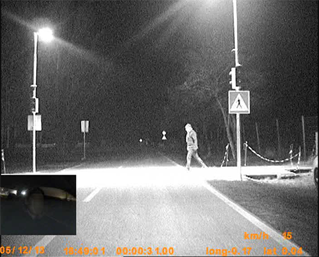Summary: Evaluation of different illumination scenarios on unregulated pedestrian crossings in dark conditions
The aim of this study was to evaluate the safety impact of new illumination elements for unregulated pedestrian crossings, such as permanent and dimmable LED lighting, retro-reflective marking material, lane lights and additional signal lights. A two-phase design was set up to assess the impact of different illumination scenarios. The first phase was the evaluation of such an equipped unregulated pedestrian crossing within a field experiment on a closed track. The second module consisted of an evaluation of the new lighting equipment by means of observations in real traffic, carried out in a small town near Vienna, Austria.
Results deriving of both investigation showed that conventional lighting conditions are associated with decreased perceptibility of pedestrians crossing the crosswalk, the approaching behaviour of drivers is characterised by later and more intense driving manoeuvres, drivers tend to brake or stop less often for pedestrians as compared to the brighter test conditions. Improvement in driving behaviour as well as subjective perceptibility and comfort could be seen in brighter illuminated conditions.
Scope
The aim of this study was to evaluate the safety impact of new illumination elements for unregulated pedestrian crossings, such as permanent and dimmable LED lighting, retro-reflective marking material, lane lights and additional signal lights. A two-phase design was set up to assess the impact of different illumination scenarios.
Method
Within the first study module, 28 subjects took part in the experiment, where individual driving behaviour when approching the equipped pedestrian crossing was observed by means of an in-vehicle data logger, measuring the drivers speed, deceleration forces and braking points within different illumination scenarios. In this experiment, a trained pedestrian was crossing in always the same manner. Additionally, the subjects have been asked to provide subjective judgments via questionnaire by means of oppositional term couples, focusing on comfort aspects, impression of the crosswalk design as well as brightness impressions.
Within study module 2, measurements were carried out to analyse peoples´ behaviour approaching a pedestrian crossing in real traffic circumstances. Therefore, the same equipment as used in the first study phase was installed in real traffic, allowing for identical lighting scenarios, i.e. a control condition with conventional lighting equipment as well as new lighting equipment resulting in four LED-based conditions. The approaching and braking behaviour was measured by an interaction observation, where a trained pedestrian crossed the crosswalk when a vehicle was approaching. Additionally, the speeds of the approaching vehicles approx. 10 meters in front of the pedestrian crossing were measured by radar. In total, about 400 pedestrian-vehicle interactions have been recorded this way.
Results
Results deriving of both investigation schemes suggest a consistent picture: conventional lighting conditions are associated with decreased perceptibility of pedestrians crossing the crosswalk, the approaching behaviour of drivers is characterised by later and more intense driving manoeuvres, drivers tend to brake or stop less often for pedestrians as compared to the brighter test conditions. A crucial improvement regarding the described behaviour could be seen when equipping crossing sites with LED-technology, despite of permanent or dimmable lighting installations. However, best results in terms of safer driving behaviour were observed in the brightest test conditions, where additional lane lights and LED signals were used.
Implications
A catalogue of recommendations has been set up, providing information under which circumstances pedestrian detection, dimmable LED illumination and/or alternately flashing LED lights should be or should not be implemented. For instance, the application of pedestrian detection is recommended for about 20% of state road pedestrian crossings and 1% of municipal road pedestrian crossings.



